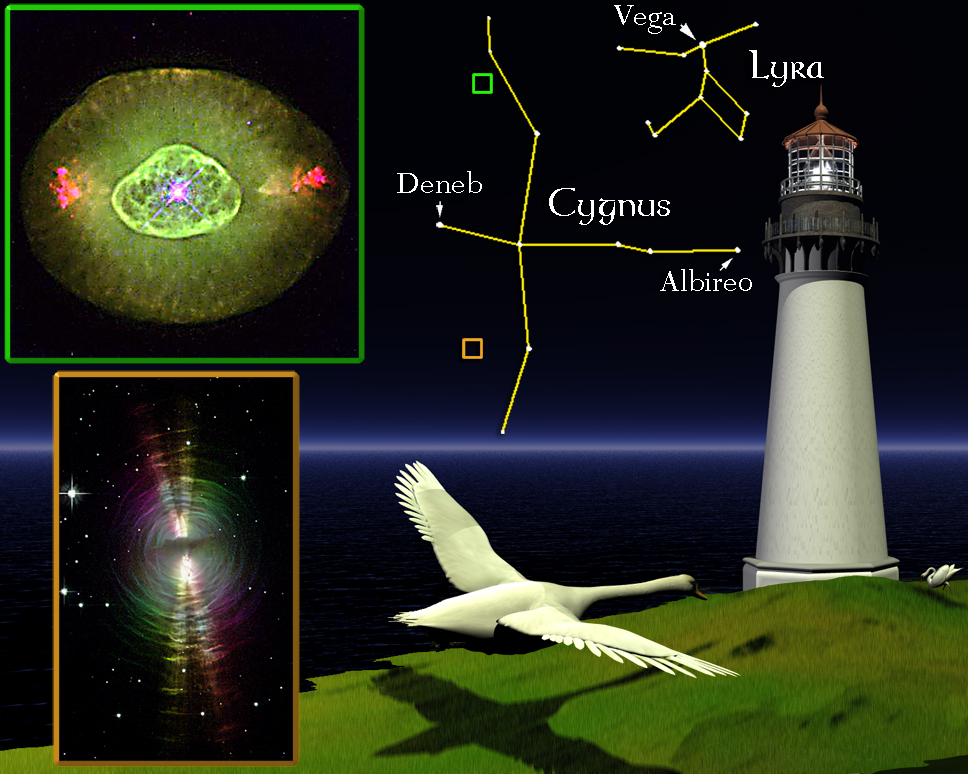
For the week including May 20, 2011

THE SWAN
There’s just something about the stars of Cygnus, the Swan, that draws attention. Even people who know very little about astronomy are able to recognize that these prominent stars ought to be part of a constellation, even if they can’t put their finger on just which constellation it is. But once someone traces the stars that outline the Swan, they have little trouble identifying it in the future. This group of stars, marking the outline of a celestial bird, has been known since the far removed ages of Babylon and Sumeria. During various periods of their histories, these cultures modeled the starry bird after storks, cranes, and even hens. Arabic peoples of a later time said that this was the giant and terrible Roc that battled with Sinbad, the Sailor.
The constellation of Cygnus, the Swan, can be found in the northeast, later in the evening. Start by looking at the large blue-white star Vega, in the constellation of Lyra, the Lyre. Vega is the brightest star in the eastern sky and shouldn’t be hard to locate. Once you’ve found it, look downward and to the left and you will come to another bright star. This is Deneb, which marks the tail of the Swan. Deneb isn’t nearly as bright as Vega, but that’s only because it’s very far away. At a distance of 1,600 light years, Deneb is probably the most remote of the brightest stars. If this supergiant were as close to us as our Sun, it would shine 60,000 times brighter. The Swan’s wings unfold to the right of Deneb and spread across a broad area of sky. Continue scanning to the right and you can follow a trail of faint stars along the Swan’s neck, ending at Albireo, the head of Cygnus.
If you have a telescope, there are some wonderful deep-sky objects for you in this constellation and Cygnus will prove well worth an evening out under the stars.
NGC 6826: The Hubble Space telescope photograph at upper left shows a star like our Sun in its death throes. As the nuclear fuel near its core runs out, the star sheds layer after layer of its outer surface into space. This phase of activity will continue for many thousands of years. The gaseous envelopes of NGC 6826 will eventually dissipate and leave behind a hot white-dwarf star that will slowly cool and fade from view. NGC 6826 is called a planetary nebula because it resembles a blurry planet in rudimentary instruments. It’s easily visible in small telescopes.
CRL 2688: The Hubble photograph at lower left gives a rare glimpse at a planetary nebula that’s only a few thousand years old. The shells of gases expanding away from the star, like the rings of a tree trunk, tell us the age of their formation. Moving at over 100,000 miles an hour, the shells were thrown away from the star at intervals ranging from 100 to 500 years. The central star inside the nebula is encased in thick shroud of gases and dust that hides it from view. Gaps in the shroud have allowed twin streams of light to escape and illuminate the structures in the enveloping cloud.
Albireo: Ask an astronomer to pick the most beautiful of the binary star systems visible in backyard telescopes and their answer will almost certainly be Albireo. A small telescope reveals that what appears to the naked eye as a single star is actually a sapphire blue star with a topaz colored companion. Together they orbit a common center of gravity.
Unless otherwise indicated, all content of this web site is the copyright of Robert Deegan and all rights are reserved.
For more information, or to comment, please contact: Bob@NightSkies.org